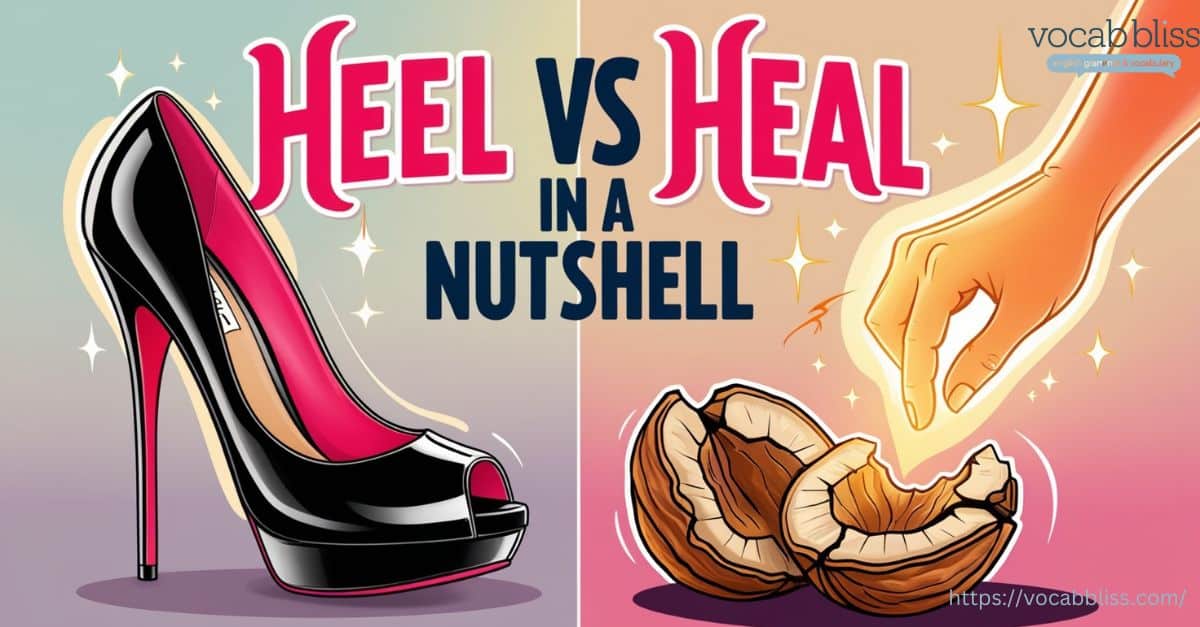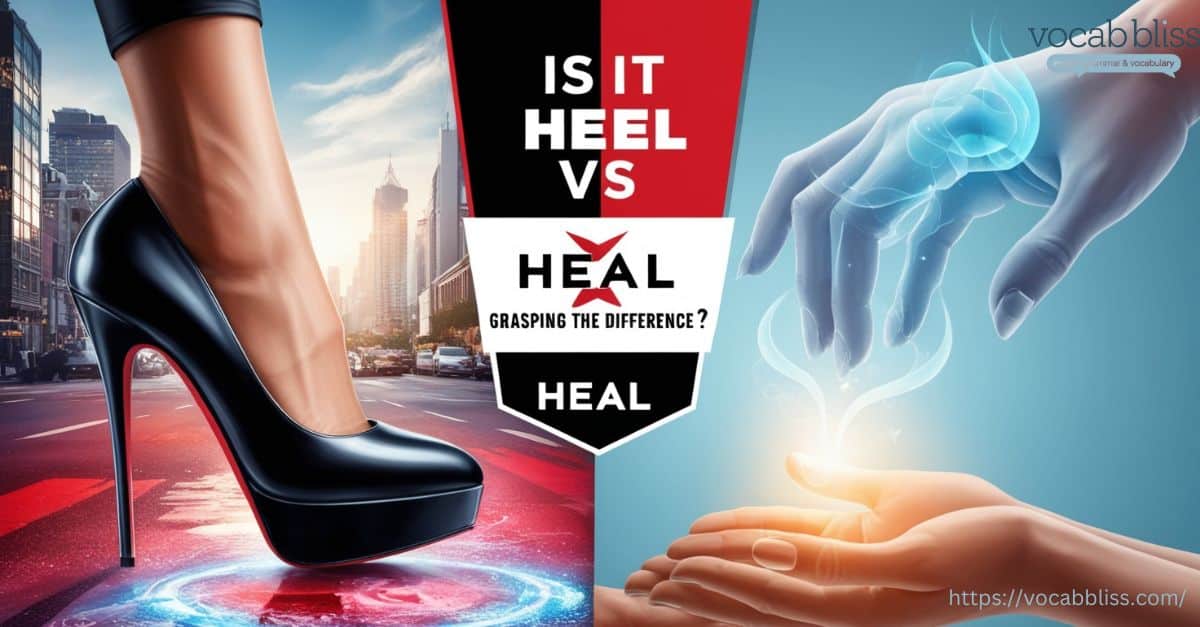Language is full of words that sound alike but carry entirely different meanings. The pair Heel vs Heal often trips people up because they are homophones — words pronounced the same but spelled differently and having different meanings.
This comprehensive guide will explore the differences between these two terms, their proper usage, and tips for mastering them. Whether you’re writing, speaking, or simply expanding your vocabulary, understanding these words will help you communicate with clarity and confidence.
Quick Summary
Understanding the difference between Heel vs Heal is key to improving your language skills. Both words are pronounced the same way, but they have very different meanings and uses. Heal refers to recovery from injury, illness, or emotional pain, while heel refers to the back part of the foot, the bottom of a shoe, or a command for a dog to walk closely. In sentences, knowing whether to use heal or heel depends on the context—whether it’s talking about physical healing, emotional recovery, or everyday actions. By familiarizing yourself with these distinctions, you can confidently choose the correct word and enhance your communication.
Read More: Inter vs Intra: Decoding the Differences
Breaking Down the Basics: Heel vs Heal
The words heel vs heal may sound identical, but their heel or heal meanings and uses couldn’t be more distinct. Here’s a quick overview:
- Heal relates to recovery or restoration, often involving health or emotional well-being.
- Heel primarily refers to a body part (the back of your foot) or a command in dog training, among other uses.
Let’s dive deeper to uncover the nuances.
What Does “Heel” Mean?

The word heel carries multiple meanings and serves different grammatical purposes, acting as both a noun and a verb. Its usage spans across anatomy, dog training, nautical terms, and even idiomatic expressions. To better understand this, let’s break it down with clarity and detail.
Definition and Origin of “Heel”
- As a noun: The heel is the rounded back part of the human foot, just below the ankle. It also refers to similar structures in animals and the part of a shoe that supports this region of the foot.
- As a verb: To heel can mean to follow closely, as a well-trained dog would, or to tilt a ship in one direction under the force of wind or waves.
Etymology
The word heel derives from Old English hēla, which has roots in Proto-Germanic hēlō, signifying the back of the foot. The verb form evolved later, influenced by practical usage in fields like training and sailing.
Examples of “Heel” in Context
Understanding heel is easier when you see it in action. Below are examples that showcase its varied meanings:
Noun Examples:
- Anatomy: “He slipped on the ice and landed on his heel, bruising it badly.”
- Footwear: “The heel of her shoe broke during the party, leaving her limping.”
- Animal reference: “The horse’s heel was cleaned before applying the shoe.”
Verb Examples:
- Dog training: “The dog heeled perfectly, walking close to his owner’s left side.”
- Nautical context: “As the storm intensified, the boat began to heel dangerously to one side.”
- Idiomatic: “The company was brought to heel by stricter government regulations.”
When and How to Use “Heel” in a Sentence
Heel can fit into various contexts, but using it correctly requires awareness of its meaning in the given situation. Here’s a guide to proper usage:
Practical Scenarios:
- Anatomy: Use heel when referring to the back part of the foot.
- Example: “Athletes often suffer from heel pain due to plantar fasciitis.”
- Dog Training: Apply heel as a command or description of a dog walking obediently beside its handler.
- Example: “The trainer taught the puppy to heel during their first lesson.”
- Nautical: Use heel to describe a ship tilting under external forces.
- Example: “The captain adjusted the sails to minimize the heel during high winds.”
Mistakes to Avoid:
- Confusing heel with heal: Avoid using heel when describing recovery or restoration.
- Incorrect: “The wound on his heel took weeks to heel.”
- Correct: “The wound on his heel took weeks to heal.”
- Using heel in place of sole: The heel is only a specific part of the foot or shoe, not the entire bottom.
- Incorrect: “The sole of her shoe is cracked, especially on the heel part.”
What Does “Heal” Mean?

The word heal is deeply connected to recovery, restoration, and well-being. Primarily used as a verb, it encapsulates the process of making or becoming whole again, whether physically, emotionally, or metaphorically.
Definition and Origin of “Heal”
- As a verb: The term heal refers to the process of recovering from an injury, illness, or emotional pain. It can also mean to repair or restore something to its original or functional state.
Etymology
Heal originates from Old English hælan, meaning “to make whole, sound, or well.” Its roots can be traced back to the Proto-Germanic term hailjan, which ties it to the concept of completeness and health. Over time, throughout history, the word has retained this core meaning.
Examples of “Heal” in Context
Here are some examples demonstrating the use of heal in various situations:
Physical Recovery:
- “It took weeks for the broken bone to heal completely.”
- “Proper rest and a balanced diet can help heal your body faster.”
Emotional Recovery:
- “After losing her job, it took time for her to heal emotionally.”
- “Kind words and support from friends helped heal the rift between them.”
Metaphorical Use:
- “The new policies aim to heal the economic divide in the country.”
- “Time has a way of healing even the deepest wounds.”
When and How to Use “Heal” in a Sentence
Knowing when to use heal requires understanding its association with recovery and repair. Use it when discussing improvements, restoration, or overcoming challenges.
Practical Scenarios:
- Physical Healing: When discussing recovery from injuries or medical conditions.
- Example: “Doctors estimated that the burn would take several months to heal.”
- Emotional Healing: When referring to overcoming grief, heartbreak, or trauma.
- Example: “After the breakup, she focused on self-care to heal emotionally.”
- Metaphorical Healing: When describing the mending of relationships, communities, or intangible issues.
- Example: “Community efforts helped heal the neighborhood after the devastating flood.”
Common Missteps and How to Avoid Them:
- Mixing up heal and heel: Remember, heal is about recovery, while heel refers to a body part or command.
- Incorrect: “The wound on her foot took weeks to heel.”
- Correct: “The wound on her foot took weeks to heal.”
- Using heal as a noun: Avoid treating heal as a noun—it’s strictly a verb.
- Incorrect: “The heal was fast after surgery.”
- Correct: “The healing process was fast after surgery.”
Heal vs. Heel: Pronunciation and Parts of Speech
Understanding the distinctions between Heel vs Heal requires clarity on how these words sound and function in a sentence. While they are homophones—words that sound alike but have different meanings—they serve distinct grammatical roles and are used in vastly different contexts.
Pronunciation: The Homophone Connection
Both Heel vs Heal are pronounced the same way: /hiːl/. This identical pronunciation is why they are often confused in writing, despite having unrelated meanings.
Phonetic Key:
- Heal: /hiːl/
- Heel: /hiːl/
The context of the sentence is crucial to determine which word is being used. For example:
- “I hope your ankle will heal soon.” (Refers to recovery.)
- “The heel of his shoe was worn out.” (Refers to the back part of the foot or shoe.)
Parts of Speech: How They Function
Heal
- Part of Speech: Verb
- Function: Describes an action—specifically, the act of recovery, restoration, or repair.
- Examples:
- “The doctor said the wound would heal in two weeks.”
- “Therapy helped her heal from the emotional trauma.”
Heel
- Part of Speech: Noun and Verb
- Functions:
- As a noun: Refers to the back part of the foot, footwear, or similar structures.
- Example: “The heel of his boot was scuffed after the hike.”
- As a verb: Indicates the act of following closely or tilting.
- Example: “The dog was trained to heel at his owner’s side.”
- In idioms: Used metaphorically to indicate submission or change of direction.
- Example: “The manager brought the unruly team to heel.”
- As a noun: Refers to the back part of the foot, footwear, or similar structures.
Side-by-Side Comparison Heel vs Heal
| Aspect | Heal | Heel |
|---|---|---|
| Pronunciation | /hiːl/ | /hiːl/ |
| Part of Speech | Verb | Noun, Verb |
| Primary Meaning | To recover, restore, or repair | The back of the foot, footwear, or to follow/tilt |
| Examples | “The cut will heal with time.” | “Her heels clicked loudly on the floor.” |
| Common Usage | Describes recovery from physical or emotional harm | Refers to anatomy, footwear, or actions |
Contextual Clues for Differentiation
When deciding whether to use Heel vs Heal, pay close attention to the sentence’s context:
- If it relates to recovery or fixing something, use heal.
- If it describes a body part, command, or tilt, use heel.
Tricks for Mastery: Heal vs Heel
Here are some handy tips to distinguish heal from heel:
- Mnemonic device: “Heal involves maladies; heel is about your heel.”
- Visualize: Picture a heel (foot) or a healing wound to reinforce memory.
- Practice: Create sentences using both words to solidify understanding.
Quick Self-Check: Fill in the Gaps

This fun and interactive section not only helps you test your understanding of heal versus heel, but it also provides an opportunity to fill in the blanks with the correct word, which can sharpen your language skills!
Read each sentence carefully and fill in the blank with either Heel vs Heal. See if you’ve got them straight!
- The ____________ (___) of his shoe was scuffed from a long day of walking.
- After the accident, it took time for his injuries to ____________ (___).
- She needed to ____________ (___) emotionally after the breakup.
- The dog was trained to ____________ (___) beside its owner during walks.
- A healthy diet can help your body ____________ (___) faster after an injury.
- He had to ____________ (___) his sprained ankle.
- The new initiative aims to ____________ (___) the financial divide within the community.
- In the storm, the boat started to ____________ (___) dangerously.
Answers
- heel
- “The heel of his shoe was scuffed from a long day of walking.”
- heal
- “After the accident, it took time for his injuries to heal.”
- heal
- “She needed to heal emotionally after the breakup.”
- heel
- “The dog was trained to heel beside its owner during walks.”
- heal
- “A healthy diet can help your body heal faster after an injury.”
- heal
- “He had to heal his sprained ankle.”
- heal
- “The new initiative aims to heal the financial divide within the community.”
- heel
- “In the storm, the boat started to heel dangerously.”
Explanation
This section provides a playful approach to mastering the differences between heal or heel. By using sentences in everyday contexts, you can easily understand their meanings and improve your vocabulary. Moreover, practicing filling in these gaps can help strengthen your grasp of these tricky homophones.
Heel vs Heal in a Nutshell

In essence:
- Use heal for anything involving recovery or restoration.
- Use heel for anatomy, commands, or tilting actions.
This distinction is key to avoiding embarrassing mix-ups.
Everyday Usage Examples
To enhance your confidence of Heel vs Heal, here are additional examples:
- Heal: “Rest will help the athlete heal from the injury.”
- Heel: “She bought gel pads to cushion her heel.”
Common Questions About Heal vs Heel
When Should Heel Be Used?
Use heel when referring to:
- The back of the foot.
- Commands in dog training.
- Tilting actions or idiomatic expressions.
When Is Heal the Correct Choice?
Choose heal for:
- Recovery, whether physical, emotional, or spiritual.
Are Heal and Heel Pronounced the Same?
Yes, both are pronounced /hiːl/.
How do you spell “heal”?
The word “heal” is spelled H-E-A-L.
What Are Common Mistakes When Using These Words?
- Confusing heal with heel when describing recovery.
- Using heal to describe anatomy or commands.
further confusing words
User:
Healing or heeling
Response:
The terms “healing vs heeling” are distinct and refer to different concepts.
- Healing pertains to the process of recovery from an injury, illness, or emotional distress.
- Heeling refers to the act of a dog walking closely beside its owner during training.
User:
Healed or heeled
Response:
The past tense of “heal” is “healed,” which describes the state of having recovered from an injury or illness.
The term “heeled” can refer to the process of adding a heel to a shoe, or in the context of dog training, to the command for a dog to walk beside its owner.
User:
Heels or heals
Response:
The word “heels” denotes the back part of a foot or the bottom part of a shoe.
On the other hand, “heals” is the plural form of “heal,” indicating multiple recoveries or instances of healing.
Heals or Heels
- Heels:
- Refers to the back part of the foot or the bottom of a shoe.
- Can also describe the command for a dog to walk closely beside its owner during training.
- Example: “She wore high heels to the party.”
- Heals:
- The plural form of “heal,” which refers to the process of recovery from an injury, illness, or emotional distress.
- Example: “The doctor said her wounds should heal within a few weeks.”
Conclusion
Understanding the differences between heal or heel is crucial for clear communication. These homophones may sound alike, but their meanings are worlds apart. By learning their heal vs heel definitions, practicing usage, and leveraging memory aids, you can confidently use these words without hesitation.
Mastering language nuances like these elevates your writing and speech, making you a more effective communicator. Now that you know the differences, why not put them into practice?

